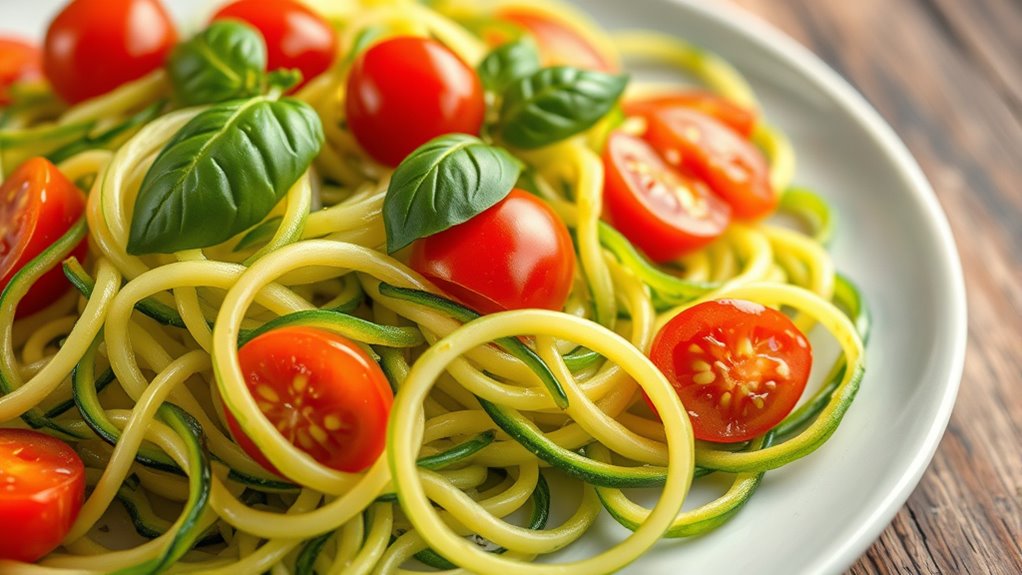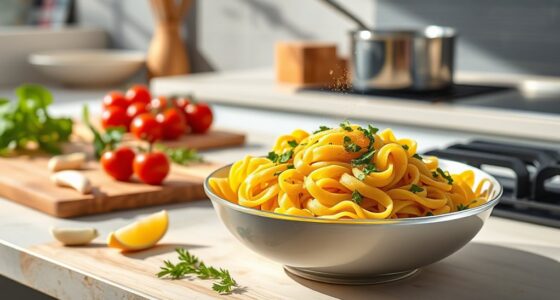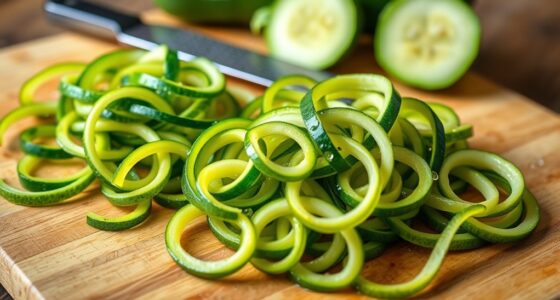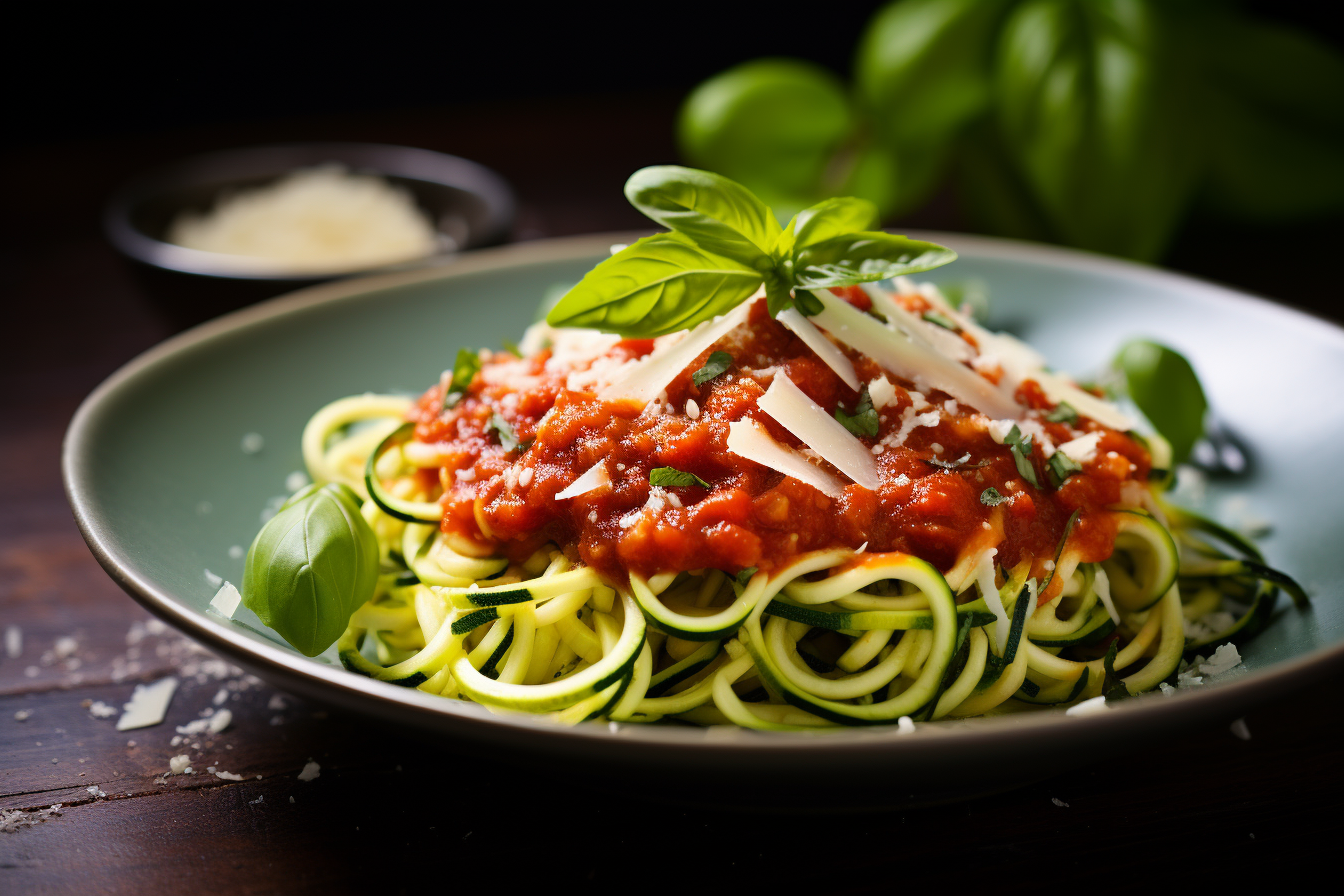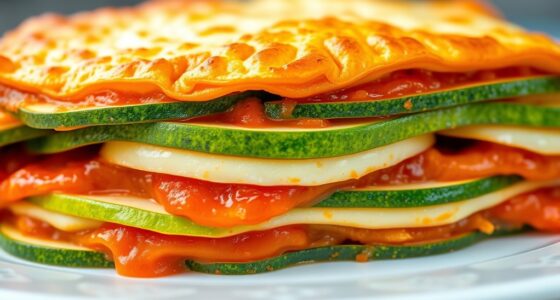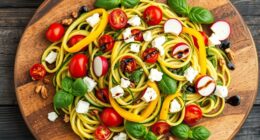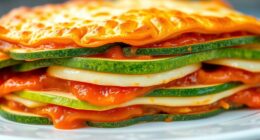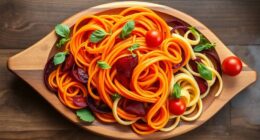To avoid watery zucchini noodle dishes, start by salting your zoodles lightly and letting them sit for 15-20 minutes to draw out excess moisture. Gently squeeze out the liquid with a towel before cooking. Choose ingredients that thicken as they cook, like garlic or cream, and add acidic flavors like lemon to balance moisture. Carefully combining the noodles and sauce and serving immediately help keep your dish crisp. Keep these tips in mind to achieve perfectly sauced zoodles every time.
Key Takeaways
- Salt zoodles lightly before cooking and let sit to draw out excess moisture, then squeeze out liquid with a towel.
- Choose ingredients like garlic, tomatoes, or cream that thicken naturally during cooking to stabilize the sauce.
- Prepare and dry zoodles thoroughly before combining with sauce to prevent water pooling and sogginess.
- Add sauces gradually and cook until they thicken, reducing excess liquid for better sauce absorption.
- Serve immediately, layering and garnishing carefully to prevent moisture buildup and maintain crispness.
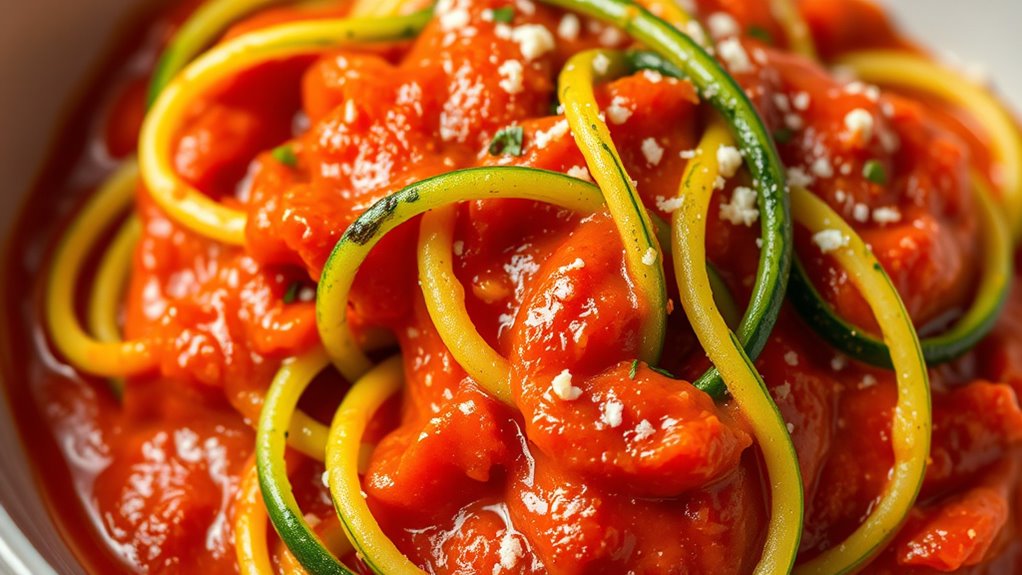
Have you ever wondered what makes certain sauces irresistibly flavorful? It’s not just about the ingredients; it’s also how you prepare and present your dish. When making zucchini noodles, or zoodles, the goal is to create a vibrant, crisp dish with a rich, well-coated sauce. But too often, watery zoodles ruin the experience, leaving your plate soggy and unappetizing. The good news is that avoiding this common pitfall comes down to a few simple techniques, starting with proper seasoning tips and presentation tricks.
First, seasoning tips are essential. Before tossing your zucchini noodles into any sauce, salt them lightly and let them sit for about 15-20 minutes. This process draws out excess moisture, so you won’t end up with a watery mess. Afterward, squeeze out any remaining liquid gently using a clean kitchen towel or paper towels. This step guarantees your noodles are as dry as possible, giving the sauce a chance to cling without diluting. When preparing your sauce, opt for ingredients that thicken as they cook—think garlic, tomatoes, or a splash of cream—so they can absorb moisture and develop depth. Adding a pinch of salt or a splash of lemon juice can enhance the flavors, making your dish taste vibrant and well-balanced. Remember, seasoning is not just about flavor; it’s about building a foundation that complements the fresh zucchini. Incorporating proper preparation techniques can significantly improve your dish’s texture and flavor.
Presentation tricks also play a critical role in avoiding watery dishes. Once your noodles are dry and your sauce is ready, combine them carefully. Use tongs or a slotted spoon to incorporate the zoodles into the sauce gently. This helps prevent excess liquid from pooling at the bottom of the plate. Serving immediately is essential, as waiting too long allows the noodles to soak up any residual moisture, turning soggy. For an appealing presentation, consider layering your zoodles neatly in the center of the plate, then spooning the sauce over the top in a controlled manner. Garnish with fresh herbs, grated cheese, or a drizzle of olive oil to add visual appeal and extra flavor. These presentation tricks not only make your dish more attractive but also help you control the moisture content by emphasizing the best qualities of each component.
In essence, avoiding watery zucchini noodle dishes involves a combination of proper seasoning tips and presentation tricks. By drying your noodles thoroughly, choosing thickening ingredients, and assembling your dish with care, you guarantee a flavorful, crisp, and visually appealing meal every time. Remember, the secret lies in the details—small adjustments can turn a soggy mess into a vibrant, delicious plate that’s as beautiful as it is tasty.
Frequently Asked Questions
Can Salt Alone Prevent Zucchini From Releasing Water?
Salt alone can help reduce zucchini’s water release, but it’s not enough by itself. Using proper salting techniques, like sprinkling salt and letting the zucchini sit, encourages moisture absorption and draws out excess water. Then, you can gently squeeze out the moisture. This process guarantees your zucchini noodles stay firm and don’t become soggy. Combining salting techniques with proper handling keeps your dish fresh and tasty.
Is There a Specific Type of Zucchini Best for Noodles?
When choosing zucchini varieties for noodles, you’re seeking those with a firm, dense texture that hold up well during cooking. The most suitable zucchini types are typically the smaller, younger ones, often called “baby zucchini” or “early harvest” varieties. These tend to have fewer seeds and less water content, ensuring your noodles stay crisp and flavorful. So, look for zucchinis labeled as “compact” or “mini” for the best results.
How Long Should Zucchini Sit After Salting?
After salting your zucchini, you should let it sit for about 15 to 30 minutes. This allows the salting techniques to draw out excess moisture effectively, preventing watery noodles. The time may vary depending on the zucchini varieties you use, as some are more watery than others. Once the time’s up, gently squeeze out the liquid to make certain your zucchini noodles stay firm and delicious.
Do Different Sauces Affect Water Release?
Different sauces do affect water release in zucchini noodles by influencing the sauce consistency and flavor impact. Thin, watery sauces can cause more water to leach out, making the dish soggy, while thicker sauces help absorb excess moisture. You should choose sauces with a richer consistency or add thickeners to prevent water from diluting flavors. This way, your zucchini retains a better texture and your dish stays flavorful.
Can Cooking Methods Reduce Excess Moisture?
Picture your zucchini noodles as thirsty sponges ready to absorb excess water. You can tame their moisture by using smart cooking techniques like salting and draining before cooking or sautéing over high heat. These methods act like a sieve, controlling moisture and preventing watery dishes. Mastering these moisture control techniques ensures your zucchini retains its texture and flavor, keeping your dish vibrant and delicious every time.
Conclusion
Now that you know how to prevent watery zucchini noodles, you’re all set to enjoy perfect, saucy dishes every time. Did you know that zucchini contains over 95% water? That’s why it’s easy for your noodles to become soggy if you don’t follow these tips. With just a little patience and the right techniques, you’ll keep your zucchini noodles tender and flavorful, making your meals healthier and more delicious—without the unwanted excess water.

